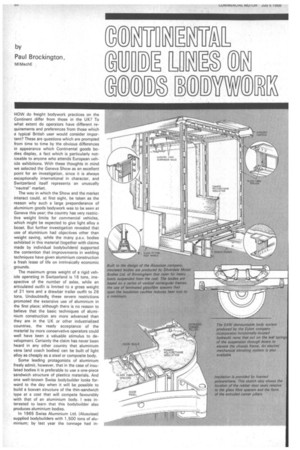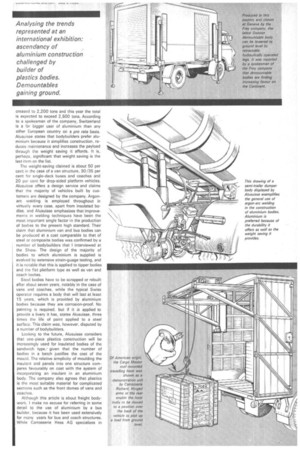_IMER171 - = ftL :21E
Page 90

Page 91

If you've noticed an error in this article please click here to report it so we can fix it.
COO BDENDRU
by Paul Brockington,
MI MechE HOW do freight bodywork practices on the Continent differ from those in the UK? To what extent do operators have different requirements and preferences from those which a typical British user would consider important? These are questions which are prompted from time to time by the obvious differences in appearance which Continental goods bodies display, a fact which is particularly noticeable to anyone who attends European vehicle exhibitions. With these thoughts in mind we selected the Geneva Show as an excellent point for an investigation, since it is always exceptionally international in character, and Switzerland itself represents an unusually "neutral" market.
The way in which the Show and the market interact could, at first sight, be taken as the reason why such a large preponderance of aluminium goods bodywork was to be seen at Geneva this year; the country has very restrictive weight limits for commercial vehicles, which might be expected to give light alloy a boost. But further investigation revealed that use of aluminium had objectives other than weight saving, while the many p.s.v. bodies exhibited in this material (together with claims made by individual bodybuilders) supported the contention that improvements in welding techniques have given aluminium construction a fresh lease of life on intrinsically economic grounds.
The maximum gross weight of a rigid vehicle operating in Switzerland is 16 tons, irrespective of the number of axles, while an articulated outfit is limited to a gross weight of 21 tons and a drawbar trailer outfit to 26 tons. Undoubtedly, these severe restrictions promoted the extensive use of aluminium in the first place; although there is no reason to believe that the basic techniques of aluminium construction are more advanced than they are in the UK or other industrialized countries, the ready acceptance of the material by more conservative operators could well have been a valuable stimulus to development. Certainly the claim has never been heard in any other country that aluminium vans (and coach bodies) can be built of light alloy as cheaply as a steel or composite body.
Some leading protagonists of aluminium freely admit, however, that in the case of insulated bodies it is preferable to use a one-piece sandwich structure of plastics materials. And one well-known Swiss bodybuilder looks forward to the day when it will be possible to build a boxvan structure of the thin-sandwich type at a cost that will compete favourably with that of an aluminium body. I was interested to learn that this bodybuilder also produces aluminium bodies.
In 1965 Swiss Aluminium Ltd. (Alusuisse) supplied bodybuilders with 1,500 tons of aluminium; by last year the tonnage had in
creased to 2,200 tons and this year the total is expected to exceed 2,500 tons. According to a spokesman of the company, Switzerland is a far bigger user of aluminium than any other European country on a pro rata basis. Alusuisse states that bodybuilders prefer aluminium because it simplifies construction, reduces maintenance and increases the payload through the weight saving it affords. It is, perhaps, significant that weight saving is the last item on the list.
The weight-saving claimed is about 50 per cent in the case of a van structure, 30/35 per cent for single-deck buses and coaches and 20 per cent for drop-sided platform vehicles. Alusuisse offers a design service and claims that the majority of vehicles built by customers are designed by the company. Argonarc welding is employed throughout in virtually every case, apart from insulated bodies. and Alusuisse emphasizes that improvements in welding techniques have been the most important single factor in the production of bodies to the present high standard. Their claim that aluminium van and bus bodies can be produced at a cost comparable to that of steel or composite bodies was confirmed by a number of bodybuilders that I interviewed at the Show. The design of the majority of bodies to which aluminium is supplied is evolved by extensive strain-guage testing, and it is notable that this is applied to tipper bodies and the flat platform type as well as van and coach bodies.
Steel bodies have to be scrapped or rebuilt after about seven years, notably in the case of vans and coaches, while the typical Swiss operator requires a body that will last at.least 15 years, which is provided by aluminium bodies because they are corrosion-proof. No painting is required, but if it is applied to provide a livery it has, states Alusuisse, three times the life of paint applied to a steel surface. This claim was, however, disputed by a number of bodybuilders.
Looking to the future, Alusuisse considers that one-piece plastics construction will be increasingly used for insulated bodies of the sandwich type,. given that the number of bodies in a batch justifies the cost of the mould. The relative simplicity of moulding the insulant and panels into one structure compares favourably on cost with the system of incorporating an insulant in an aluminium / body. The company also agrees that plastics is the most suitable material for complicated sections such as•the front domes of vans and coaches.
Although this article is about freight bodywork, I make no excuse for referring in some detail to the use of aluminium by a bus builder, because it has been used extensively for many years for bus and coach structures. While Carrosserie Hess AG specializes in
























































































































































